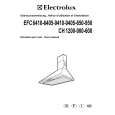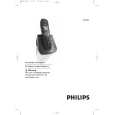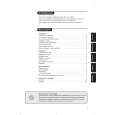|
|
|
Productos
|
|
Información
|
|
Destacado
|
|
|
 |
|
|
No hay comentarios de productos.
EN 66
9.
L01.1E AB
Circuit Description
voltage on pin 54 is normally 3.3 V (limiter not active). During set switch �off�, the black current control circuit generates a fixed beam current of 1 mA. This current ensures that the picture tube capacitance is discharged. During the switch-off period, the vertical deflection is placed in an over-scan position, so that the discharge is not visible on the screen. 9.3.7 RGB Amplifier From outputs 56, 57 and 58 of IC7200, the RGB signals are applied to the integrated output amplifier (7330) on the CRT panel. Via the outputs 7, 8 and 9, the picture tube cathodes are driven. The supply voltage for the amplifier is +200 V and is derived from the line output stage. 9.3.8 SCAVEM (if present) The SCAn VElocity Modulation (SCAVEM) circuitry is implemented in the layout of the picture tube panel. It is thus not an extra module. This circuit influences the horizontal deflection as a function of the picture content. In an ideal square wave, the sides are limited in slope due to a limited bandwidth (5 MHz). SCAVEM will improve the slope as follows: At a positive slope, a SCAVEM current is generated which supports the deflection current. At the first half of the slope, the spot is accelerated and the picture is darker. At the second half of the slope, the spot is delayed and the slope becomes steeper. At the end of the slope, the SCAVEM-current decays to zero and the spot is at the original position. An overshoot occurs which improves the impression of sharpness. At the negative slope, the SCAVEM-current counteracts the deflection. During the first half of the slope, the spot is delayed and the slope becomes steeper. During the second half the spot accelerates, the SCAVEM-current is zero at the end of the slope. Via the three resistors R3371, R3379 and R3386, Red, Green and Blue are added together, buffered and offered to the emitter of TS7363. On the collector of this transistor, configured in a common base, the sum of these 3 signals is obtained. Via the emitter follower formed with TS7360, this signal is conveyed to the differentiator C2376 and R3392. Only the high frequencies are differentiated (small RC-time). The positive and negative pulses of this signal drive respectively TS7365 and TS7362 into conductivity. The DC setting of the output stage is set by R3363, R3374, R3378 and R3384. The working voltage of the transistors is settled at half the supply voltage. At the positive section of the pulse, the current flows through TS7365 and the SCAVEM coil. At the negative section of the pulse, the current flows through TS7362 and the SCAVEM coil.
Also some picture improvement features are implemented in this part: � Black stretch This function corrects the black level of incoming signals, which have a difference between the black level and the blanking level. The amount of extension depends upon the difference between actual black level and the darkest part of the incoming video signal level. It is detected by means of an internal capacitor. � White stretch This function adapts the transfer characteristic of the luminance amplifier in a non-linear way depending on the average picture content of the luminance signal. It operates in such a way that maximum stretching is obtained when signals with a low video level are received. For bright pictures, stretching is not active. � Dynamic skin tone correction This circuit corrects (instantaneously and locally) the hue of those colours which are located in the area in the UV plane that matches the skin tone. The correction is dependent on the luminance, saturation and distance to the preferred axis. The YUV signal is then fed to the colour matrix circuit, which converts it to R, G and B signals. The OSD/TXT signal from the microprocessor is mixed with the main signal at this point, before being output to the CRT board (pins 56, 57 and 58). 9.3.6 RGB Control The RGB control circuit enables the picture parameters contrast, brightness and saturation to be adjusted, by using a combination of the user menus and the remote control. Additionally automatic gain control for the RGB signals via cutoff stabilisation is achieved in this functional block to obtain an accurate biasing of the picture tube. Therefor this block inserts the cut-off point measuring pulses into the RGB signals during the vertical retrace period. The following additional controls are used: � Black current calibration loop Because of the 2-point black current stabilisation circuit, both the black level and the amplitude of the RGB output signals depend on the drive characteristics of the picture tube. The system checks whether the returning measuring currents meet the requirements, and adapt the output level and gain of the circuit when necessary. After stabilisation of the loop, the RGB drive signals are switched on. The 2-point black level system adapts the drive voltage for each cathode in such a way that the two measuring currents have the right value. This is done with the measurement pulses during the frame flyback. During the first frame, three pulses with a current of 8 µA are generated to adjust the cut off voltage. During the second frame, three pulses with a current of 20 µA are generated to adjust the �white drive�. This has as a consequence, that a change in the gain of the output stage will be compensated by a gain change of the RGB control circuit. Pin 55 (BLKIN) of the UOC is used as the feedback input from the CRT base panel. � Blue stretch This function increases the colour temperature of the bright scenes (amplitudes which exceed a value of 80% of the nominal amplitude). This effect is obtained by decreasing the small signal gain of the red and green channel signals, which exceed this 80% level. � Beam current limiting A beam current limiting circuit inside the UOC handles the contrast and brightness control for the RGB signals. This prevents the CRT from being overdriven, which could otherwise cause serious damage in the line output stage. The reference used for this purpose is the DC voltage on pin 54 (BLCIN) of the TV processor. Contrast and brightness reduction of the RGB output signals is therefore proportional to the voltage present on this pin. Contrast reduction starts when the voltage on pin 54 is lower than 2.8 V. Brightness reduction starts when the voltage on pin 54 is less than 1.7 V. The
9.4
Synchronisation
Inside IC7200 (part D), the vertical and horizontal sync-pulses are separated. These �H� and �V� signals are synchronised with the incoming CVBS signal. They are then fed to the H- and Vdrive circuits and to the OSD/TXT circuit for synchronisation of the On Screen Display and Teletext (or Closed Caption) information.
9.5
9.5.1
Deflection
Horizontal Drive The horizontal drive signal is obtained from an internal VCO, which is running at twice the line frequency. This frequency is
|
|
 |
> |
|










